feign实现远程调用原理
- 格式:doc
- 大小:12.45 KB
- 文档页数:2
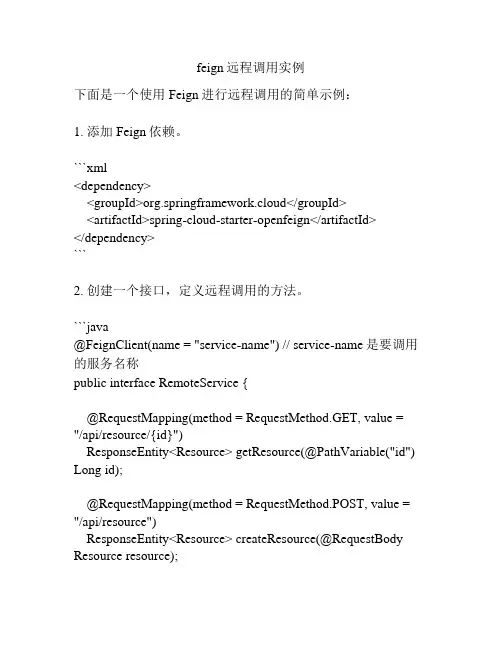
feign远程调用实例下面是一个使用Feign进行远程调用的简单示例:1. 添加Feign依赖。
```xml<dependency><groupId>org.springframework.cloud</groupId><artifactId>spring-cloud-starter-openfeign</artifactId></dependency>```2. 创建一个接口,定义远程调用的方法。
```java@FeignClient(name = "service-name") // service-name是要调用的服务名称public interface RemoteService {@RequestMapping(method = RequestMethod.GET, value = "/api/resource/{id}")ResponseEntity<Resource> getResource(@PathVariable("id") Long id);@RequestMapping(method = RequestMethod.POST, value = "/api/resource")ResponseEntity<Resource> createResource(@RequestBody Resource resource);// ...}```3. 在应用程序中使用该接口。
```java@RestControllerpublic class MyController {@Autowiredprivate RemoteService remoteService;@GetMapping("/resources/{id}")public ResponseEntity<Resource> getResource(@PathVariable Long id) {return remoteService.getResource(id);}@PostMapping("/resources")public ResponseEntity<Resource>createResource(@RequestBody Resource resource) {return remoteService.createResource(resource);}// ...}```4. 配置Feignclient。

feign远程调用工作原理
Feign 是一个 Java 语言编写的 HTTP 客户端框架,主要用于简化微服务架构中的远程服务调用。
Feign 通过注解方式定义接口,并通过动态代理技术生成接口的实现类,使得开发者可以像调用本地接口一样调用远程服务。
Feign 的远程调用工作原理可以概括为以下几个步骤:
1.定义接口:开发者使用Feign 提供的注解方式定义远程服务的接口,并在
注解中指定服务地址和相关参数,如请求方法、请求头、请求体等。
2.动态代理:在应用启动时,Feign 使用动态代理技术生成接口的实现类,并
将其注册到 Spring 容器中。
3.请求转发:当调用远程服务时,Feign 会将接口方法的参数和注解信息封装
成 HTTP 请求,并发送到指定的服务地址。
4.响应处理:远程服务接收到请求后进行处理,并将处理结果封装成 HTTP 响
应返回给 Feign。
Feign 将响应解析成接口方法的返回类型,并返回给调用方。
需要注意的是,Feign 的远程调用工作原理基于 HTTP 协议,因此对网络性能和稳定性要求较高。
此外,Feign 还提供了多种配置选项,例如超时时间、负载均衡等,可以根据实际情况进行调整以保证远程服务调用的稳定性和性能。
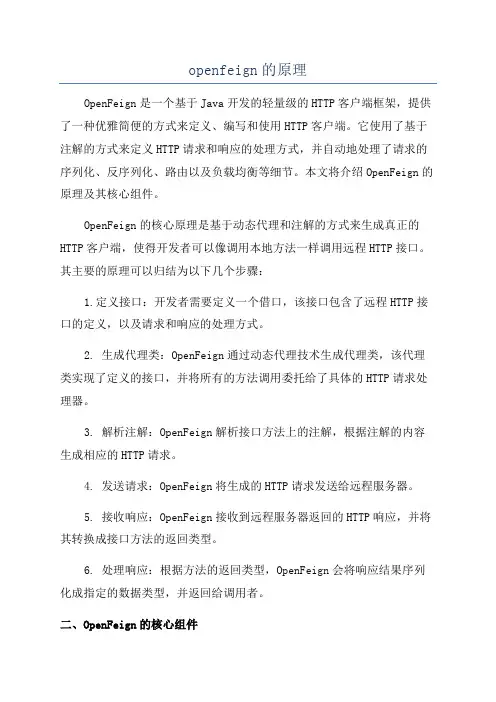
openfeign的原理OpenFeign是一个基于Java开发的轻量级的HTTP客户端框架,提供了一种优雅简便的方式来定义、编写和使用HTTP客户端。
它使用了基于注解的方式来定义HTTP请求和响应的处理方式,并自动地处理了请求的序列化、反序列化、路由以及负载均衡等细节。
本文将介绍OpenFeign的原理及其核心组件。
OpenFeign的核心原理是基于动态代理和注解的方式来生成真正的HTTP客户端,使得开发者可以像调用本地方法一样调用远程HTTP接口。
其主要的原理可以归结为以下几个步骤:1.定义接口:开发者需要定义一个借口,该接口包含了远程HTTP接口的定义,以及请求和响应的处理方式。
2. 生成代理类:OpenFeign通过动态代理技术生成代理类,该代理类实现了定义的接口,并将所有的方法调用委托给了具体的HTTP请求处理器。
3. 解析注解:OpenFeign解析接口方法上的注解,根据注解的内容生成相应的HTTP请求。
4. 发送请求:OpenFeign将生成的HTTP请求发送给远程服务器。
5. 接收响应:OpenFeign接收到远程服务器返回的HTTP响应,并将其转换成接口方法的返回类型。
6. 处理响应:根据方法的返回类型,OpenFeign会将响应结果序列化成指定的数据类型,并返回给调用者。
二、OpenFeign的核心组件OpenFeign的核心组件包括以下几个部分:1.注解解析器:用于解析接口方法上的注解,包括HTTP请求方法、路径、请求参数、响应类型等信息。
2. 请求处理器:负责将解析得到的注解信息封装成HTTP请求对象,并发送给远程服务器。
可以使用Apache HttpClient或者OkHttp作为底层的HTTP客户端。
3.序列化器:负责将HTTP请求或响应的数据进行序列化和反序列化。
支持多种数据格式,如JSON、XML等。
4. 负载均衡器:OpenFeign可以集成负载均衡器,使得请求可以平均分散到多个服务实例上,提高系统的可用性和性能。
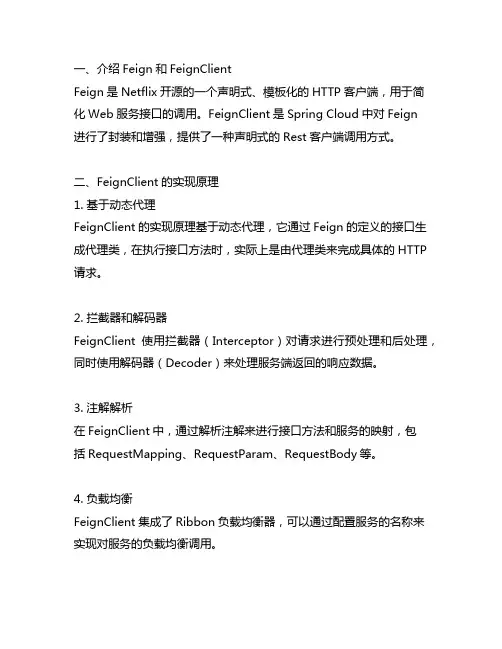
一、介绍Feign和FeignClientFeign是Netflix开源的一个声明式、模板化的HTTP客户端,用于简化Web服务接口的调用。
FeignClient是Spring Cloud中对Feign进行了封装和增强,提供了一种声明式的Rest客户端调用方式。
二、FeignClient的实现原理1. 基于动态代理FeignClient的实现原理基于动态代理,它通过Feign的定义的接口生成代理类,在执行接口方法时,实际上是由代理类来完成具体的HTTP 请求。
2. 拦截器和解码器FeignClient使用拦截器(Interceptor)对请求进行预处理和后处理,同时使用解码器(Decoder)来处理服务端返回的响应数据。
3. 注解解析在FeignClient中,通过解析注解来进行接口方法和服务的映射,包括RequestMapping、RequestParam、RequestBody等。
4. 负载均衡FeignClient集成了Ribbon负载均衡器,可以通过配置服务的名称来实现对服务的负载均衡调用。
5. 整合HystrixFeignClient可以集成Hystrix来实现对服务调用的熔断和容错处理,增强了系统的可靠性和稳定性。
6. 自定义配置FeignClient可以通过自定义配置来改变默认的请求处理逻辑,如超时设置、重试机制等。
三、使用FeignClient的注意事项1. 接口定义规范在使用FeignClient时,需严格按照接口定义规范编写接口方法,包括参数的注解、返回类型等。
2. 错误处理在调用远程服务时,需考虑对错误情况的处理,如超时、网络异常、服务端错误等。
3. 服务注册与发现FeignClient需要结合Eureka、Consul等服务注册与发现组件来实现对服务的动态发现和调用。
四、结语FeignClient作为Spring Cloud中的重要组件,提供了一种优雅的服务调用方式。
通过深入了解其实现原理,可以更好地使用和定制FeignClient,提高系统的性能和稳定性。
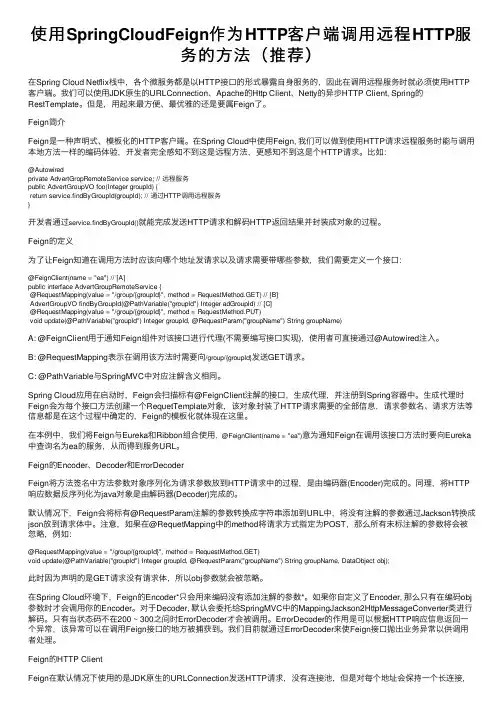
使⽤SpringCloudFeign作为HTTP客户端调⽤远程HTTP服务的⽅法(推荐)在Spring Cloud Netflix栈中,各个微服务都是以HTTP接⼝的形式暴露⾃⾝服务的,因此在调⽤远程服务时就必须使⽤HTTP 客户端。
我们可以使⽤JDK原⽣的URLConnection、Apache的Http Client、Netty的异步HTTP Client, Spring的RestTemplate。
但是,⽤起来最⽅便、最优雅的还是要属Feign了。
Feign简介Feign是⼀种声明式、模板化的HTTP客户端。
在Spring Cloud中使⽤Feign, 我们可以做到使⽤HTTP请求远程服务时能与调⽤本地⽅法⼀样的编码体验,开发者完全感知不到这是远程⽅法,更感知不到这是个HTTP请求。
⽐如:@Autowiredprivate AdvertGropRemoteService service; // 远程服务public AdvertGroupVO foo(Integer groupId) {return service.findByGroupId(groupId); // 通过HTTP调⽤远程服务}开发者通过service.findByGroupId()就能完成发送HTTP请求和解码HTTP返回结果并封装成对象的过程。
Feign的定义为了让Feign知道在调⽤⽅法时应该向哪个地址发请求以及请求需要带哪些参数,我们需要定义⼀个接⼝:@FeignClient(name = "ea") // [A]public interface AdvertGroupRemoteService {@RequestMapping(value = "/group/{groupId}", method = RequestMethod.GET) // [B]AdvertGroupVO findByGroupId(@PathVariable("groupId") Integer adGroupId) // [C]@RequestMapping(value = "/group/{groupId}", method = RequestMethod.PUT)void update(@PathVariable("groupId") Integer groupId, @RequestParam("groupName") String groupName)A: @FeignClient⽤于通知Feign组件对该接⼝进⾏代理(不需要编写接⼝实现),使⽤者可直接通过@Autowired注⼊。
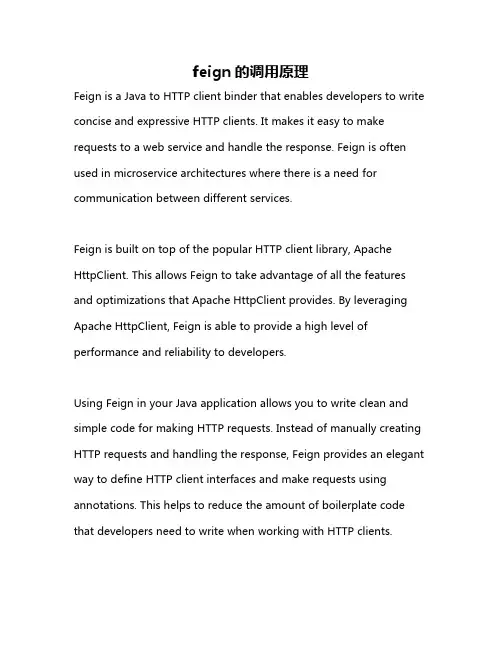
feign的调用原理Feign is a Java to HTTP client binder that enables developers to write concise and expressive HTTP clients. It makes it easy to make requests to a web service and handle the response. Feign is often used in microservice architectures where there is a need for communication between different services.Feign is built on top of the popular HTTP client library, Apache HttpClient. This allows Feign to take advantage of all the features and optimizations that Apache HttpClient provides. By leveraging Apache HttpClient, Feign is able to provide a high level of performance and reliability to developers.Using Feign in your Java application allows you to write clean and simple code for making HTTP requests. Instead of manually creating HTTP requests and handling the response, Feign provides an elegant way to define HTTP client interfaces and make requests using annotations. This helps to reduce the amount of boilerplate code that developers need to write when working with HTTP clients.One of the key features of Feign is its declarative approach to creating HTTP clients. Developers can define an interface with methods that represent different HTTP endpoints, along with annotations that specify the details of the request. This makes it easy to understand and maintain the code, as the logic for making HTTP requests is clearly defined within the interface.Feign also supports integration with other libraries and frameworks in the Java ecosystem. For example, it can seamlessly integrate with Spring Cloud, allowing developers to easily incorporate Feign clients into their microservices architecture. This makes it easy to build and maintain communication between microservices, reducing the complexity of managing inter-service communication.Another benefit of using Feign is the ability to handle errors and exceptions in a centralized manner. Feign provides ways to specify error handling logic, allowing developers to easily define how different types of errors should be handled. This helps to ensure consistent error handling across the application and simplifies the process of dealing with unexpected issues.In conclusion, Feign is a powerful tool for building HTTP clients in Java applications. Its integration with Apache HttpClient, declarative approach to defining HTTP clients, and support for other libraries make it a valuable choice for developers working with microservices and web APIs. By using Feign, developers can write clean and expressive code for making HTTP requests, while benefiting from the performance and reliability of Apache HttpClient.。
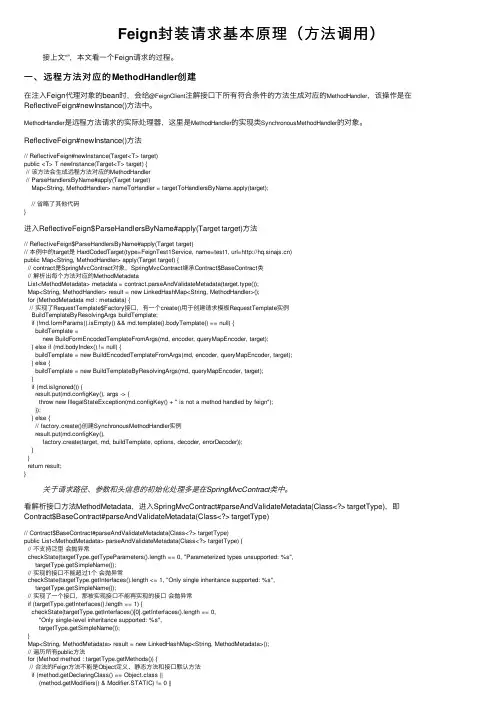
Feign封装请求基本原理(⽅法调⽤)接上⽂“”,本⽂看⼀个Feign请求的过程。
⼀、远程⽅法对应的MethodHandler创建在注⼊Feign代理对象的bean时,会给@FeignClient注解接⼝下所有符合条件的⽅法⽣成对应的MethodHandler,该操作是在ReflectiveFeign#newInstance()⽅法中。
MethodHandler是远程⽅法请求的实际处理器,这⾥是MethodHandler的实现类SynchronousMethodHandler的对象。
ReflectiveFeign#newInstance()⽅法// ReflectiveFeign#newInstance(Target<T> target)public <T> T newInstance(Target<T> target) {// 该⽅法会⽣成远程⽅法对应的MethodHandler// ParseHandlersByName#apply(Target target)Map<String, MethodHandler> nameToHandler = targetToHandlersByName.apply(target);// 省略了其他代码}进⼊ReflectiveFeign$ParseHandlersByName#apply(Target target)⽅法// ReflectiveFeign$ParseHandlersByName#apply(Target target)// 本例中的target是 HardCodedTarget(type=FeignTest1Service, name=test1, url=)public Map<String, MethodHandler> apply(Target target) {// contract是SpringMvcContract对象,SpringMvcContract继承Contract$BaseContract类// 解析出每个⽅法对应的MethodMetadataList<MethodMetadata> metadata = contract.parseAndValidateMetadata(target.type());Map<String, MethodHandler> result = new LinkedHashMap<String, MethodHandler>();for (MethodMetadata md : metadata) {// 实现了RequestTemplate$Factory接⼝,有⼀个create()⽤于创建请求模板RequestTemplate实例BuildTemplateByResolvingArgs buildTemplate;if (!md.formParams().isEmpty() && md.template().bodyTemplate() == null) {buildTemplate =new BuildFormEncodedTemplateFromArgs(md, encoder, queryMapEncoder, target);} else if (md.bodyIndex() != null) {buildTemplate = new BuildEncodedTemplateFromArgs(md, encoder, queryMapEncoder, target);} else {buildTemplate = new BuildTemplateByResolvingArgs(md, queryMapEncoder, target);}if (md.isIgnored()) {result.put(md.configKey(), args -> {throw new IllegalStateException(md.configKey() + " is not a method handled by feign");});} else {// factory.create()创建SynchronousMethodHandler实例result.put(md.configKey(),factory.create(target, md, buildTemplate, options, decoder, errorDecoder));}}return result;}关于请求路径、参数和头信息的初始化处理多是在SpringMvcContract类中。
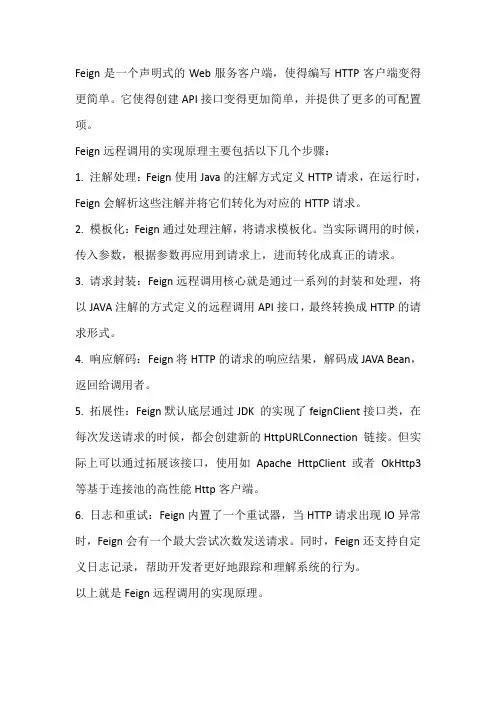
Feign是一个声明式的Web服务客户端,使得编写HTTP客户端变得更简单。
它使得创建API接口变得更加简单,并提供了更多的可配置项。
Feign远程调用的实现原理主要包括以下几个步骤:
1. 注解处理:Feign使用Java的注解方式定义HTTP请求,在运行时,Feign会解析这些注解并将它们转化为对应的HTTP请求。
2. 模板化:Feign通过处理注解,将请求模板化。
当实际调用的时候,传入参数,根据参数再应用到请求上,进而转化成真正的请求。
3. 请求封装:Feign远程调用核心就是通过一系列的封装和处理,将以JAVA注解的方式定义的远程调用API接口,最终转换成HTTP的请求形式。
4. 响应解码:Feign将HTTP的请求的响应结果,解码成JAVA Bean,返回给调用者。
5. 拓展性:Feign默认底层通过JDK 的实现了feignClient接口类,在每次发送请求的时候,都会创建新的HttpURLConnection 链接。
但实际上可以通过拓展该接口,使用如Apache HttpClient 或者OkHttp3等基于连接池的高性能Http客户端。
6. 日志和重试:Feign内置了一个重试器,当HTTP请求出现IO异常时,Feign会有一个最大尝试次数发送请求。
同时,Feign还支持自定义日志记录,帮助开发者更好地跟踪和理解系统的行为。
以上就是Feign远程调用的实现原理。
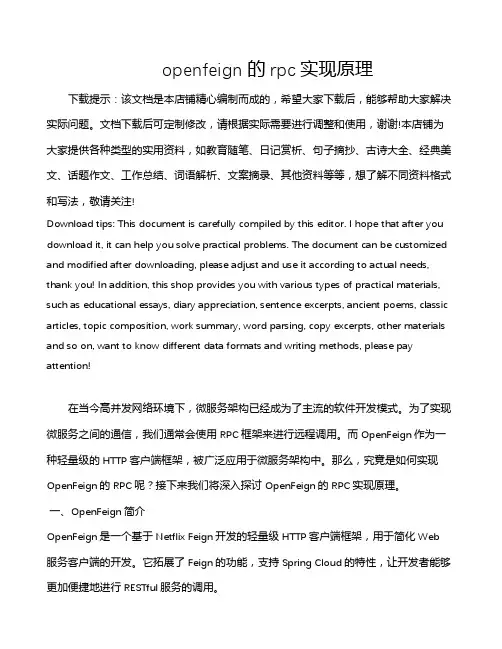
openfeign的rpc实现原理下载提示:该文档是本店铺精心编制而成的,希望大家下载后,能够帮助大家解决实际问题。
文档下载后可定制修改,请根据实际需要进行调整和使用,谢谢!本店铺为大家提供各种类型的实用资料,如教育随笔、日记赏析、句子摘抄、古诗大全、经典美文、话题作文、工作总结、词语解析、文案摘录、其他资料等等,想了解不同资料格式和写法,敬请关注!Download tips: This document is carefully compiled by this editor. I hope that after you download it, it can help you solve practical problems. The document can be customized and modified after downloading, please adjust and use it according to actual needs, thank you! In addition, this shop provides you with various types of practical materials, such as educational essays, diary appreciation, sentence excerpts, ancient poems, classic articles, topic composition, work summary, word parsing, copy excerpts, other materials and so on, want to know different data formats and writing methods, please pay attention!在当今高并发网络环境下,微服务架构已经成为了主流的软件开发模式。
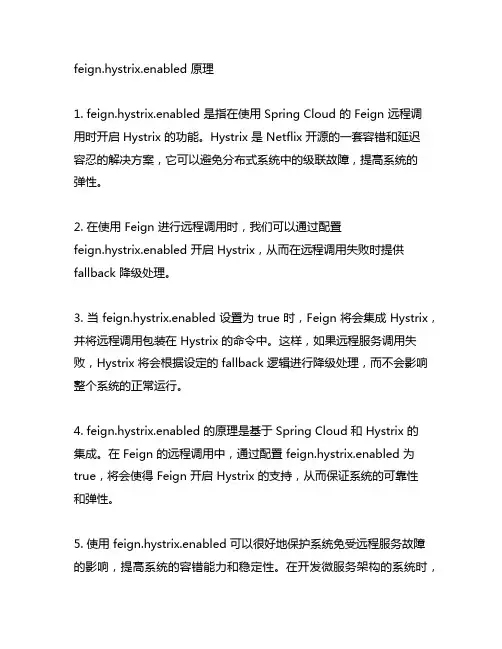
feign.hystrix.enabled 原理1. feign.hystrix.enabled 是指在使用 Spring Cloud 的 Feign 远程调用时开启 Hystrix 的功能。
Hystrix 是 Netflix 开源的一套容错和延迟容忍的解决方案,它可以避免分布式系统中的级联故障,提高系统的弹性。
2. 在使用 Feign 进行远程调用时,我们可以通过配置feign.hystrix.enabled 开启 Hystrix,从而在远程调用失败时提供fallback 降级处理。
3. 当 feign.hystrix.enabled 设置为 true 时,Feign 将会集成 Hystrix,并将远程调用包装在 Hystrix 的命令中。
这样,如果远程服务调用失败,Hystrix 将会根据设定的 fallback 逻辑进行降级处理,而不会影响整个系统的正常运行。
4. feign.hystrix.enabled 的原理是基于 Spring Cloud 和 Hystrix 的集成。
在 Feign 的远程调用中,通过配置 feign.hystrix.enabled 为true,将会使得 Feign 开启 Hystrix 的支持,从而保证系统的可靠性和弹性。
5. 使用 feign.hystrix.enabled 可以很好地保护系统免受远程服务故障的影响,提高系统的容错能力和稳定性。
在开发微服务架构的系统时,合适地配置 feign.hystrix.enabled 是非常重要的。
6. feign.hystrix.enabled 的原理是通过设置为 true 来开启 Feign 对Hystrix 的支持,从而在远程服务调用失败时提供 fallback 降级处理,保护系统的稳定性和可靠性。
7. 需要注意的是,在使用 feign.hystrix.enabled 时,我们还需要适当地配置 Hystrix 的相关参数,如超时时间、线程池大小等,以保证Hystrix 的有效运行。
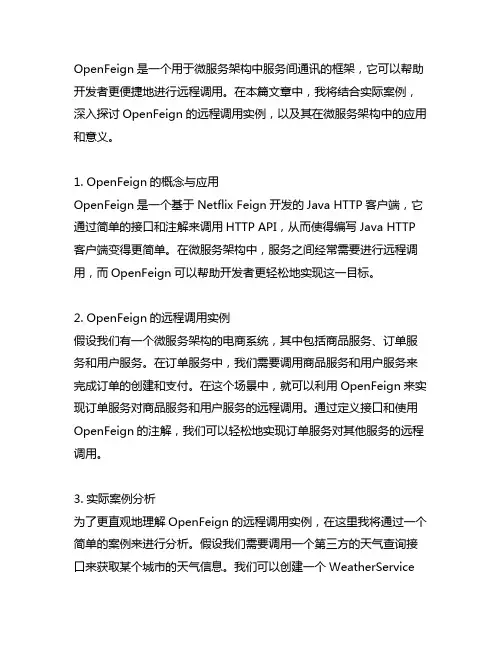
OpenFeign是一个用于微服务架构中服务间通讯的框架,它可以帮助开发者更便捷地进行远程调用。
在本篇文章中,我将结合实际案例,深入探讨OpenFeign的远程调用实例,以及其在微服务架构中的应用和意义。
1. OpenFeign的概念与应用OpenFeign是一个基于Netflix Feign开发的Java HTTP客户端,它通过简单的接口和注解来调用HTTP API,从而使得编写Java HTTP 客户端变得更简单。
在微服务架构中,服务之间经常需要进行远程调用,而OpenFeign可以帮助开发者更轻松地实现这一目标。
2. OpenFeign的远程调用实例假设我们有一个微服务架构的电商系统,其中包括商品服务、订单服务和用户服务。
在订单服务中,我们需要调用商品服务和用户服务来完成订单的创建和支付。
在这个场景中,就可以利用OpenFeign来实现订单服务对商品服务和用户服务的远程调用。
通过定义接口和使用OpenFeign的注解,我们可以轻松地实现订单服务对其他服务的远程调用。
3. 实际案例分析为了更直观地理解OpenFeign的远程调用实例,在这里我将通过一个简单的案例来进行分析。
假设我们需要调用一个第三方的天气查询接口来获取某个城市的天气信息。
我们可以创建一个WeatherService接口,并使用@FeignClient注解来指定要调用的天气查询服务。
定义一个WeatherServiceFallback类来处理远程调用失败时的降级策略。
在需要使用天气查询的地方,我们只需要注入WeatherService接口并调用相应的方法即可。
4. 总结与展望通过本文的分析,我们可以看到OpenFeign在微服务架构中的远程调用实例的应用和意义。
它使得服务间的通讯变得更加简单和高效,同时也提高了系统的可扩展性和健壮性。
未来,随着微服务架构的不断演进和完善,OpenFeign的地位和作用也将变得更加重要和广泛。
OpenFeign的远程调用实例不仅是一个技术层面上的工具和解决方案,更是对微服务架构理念的认可和践行。
springBoot使⽤feign实现远程接⼝调⽤和错误熔断1.第⼀步,新建两个简单的springboot项⽬并创建rest接⼝demo系统的rest接⼝plus系统的调⽤接⼝2.在项⽬pom⽂件⾥导⼊feign和hystrix的pom依赖包<properties><java.version>1.8</java.version><spring-cloud.version>Greenwich.SR1</spring-cloud.version></properties><!-- ⽀持使⽤feign客户端 --><dependency><groupId>org.springframework.cloud</groupId><artifactId>spring-cloud-starter-openfeign</artifactId></dependency><!-- ⽀持使⽤hystrix断路器 --><dependency><groupId>org.springframework.cloud</groupId><artifactId>spring-cloud-starter-netflix-hystrix</artifactId></dependency><dependencyManagement><dependencies><dependency><groupId>org.springframework.cloud</groupId><artifactId>spring-cloud-dependencies</artifactId><version>${spring-cloud.version}</version><type>pom</type><scope>import</scope></dependency></dependencies></dependencyManagement>3.创建远程调⽤client及熔断回调类package com.mybatis.plus.web.client;import org.springframework.cloud.openfeign.FeignClient;import org.springframework.web.bind.annotation.RequestMapping;@FeignClient(name="demo",url="${conf.address.demo}",fallbackFactory=DemoFeignClientFB.class)public interface DemoFeignClient {@RequestMapping("cmpOclOrder/demoFeign")public String testFeign();}package com.mybatis.plus.web.client;import feign.hystrix.FallbackFactory;import mons.logging.Log;import mons.logging.LogFactory;import ponent;@Componentpublic class DemoFeignClientFB implements FallbackFactory<DemoFeignClient> {private static Log logger = LogFactory.getLog(DemoFeignClientFB.class);@Overridepublic DemoFeignClient create(Throwable throwable) {return new DemoFeignClient() {@Overridepublic String testFeign() {return"demo系统接⼝调⽤失败";}};}}这⾥的url在配置⽂件⾥⾯有定义(就是需要调⽤系统的IP及端⼝)如果要⽀持熔断(如果调⽤远程接⼝报错,远程接⼝就返回⼀个固定的值)需要在配置⽂件⾥启⽤hystrix4.在启动类上加上⽀持feign的注解就ok了(这⾥basePackages值是定义client类的包路径)5.测试效果展⽰调⽤plus系统的plusTest接⼝demo系统接⼝时报错(修改代码-重启)返回固定的值以上就是简单的feign+hystrix的应⽤。
Feign远程调⽤⼀、Feign简介Feign是Netflix开发的⼀个轻量级RESTful的HTTP服务客户端(⽤它来发起请求,远程调⽤的),是以Java接⼝注解的⽅式调⽤Http请求,⽽不⽤像Java中通过封装 HTTP请求报⽂的⽅式直接调⽤,Feign被⼴泛应⽤在Spring Cloud 的解决⽅案中。
类似于Dubbo,服务消费者拿到服务提供者的接⼝,然后像调⽤本地接⼝⽅法⼀样去调⽤,实际发出的是远程的请求Feign可帮助我们更加便捷,优雅的调⽤HTTP API:不需要我们去拼接url然后呢调⽤restTemplate的api,在SpringCloud中,使⽤Feign⾮常简单,创建⼀个接⼝(在消费者--服务调⽤⽅这⼀端),并在接⼝上添加⼀些注解,代码就完成了SpringCloud对Feign进⾏了增强,使Feign⽀持了SpringMVC注解 (OpenFeign)本质:封装了Http调⽤流程,更符合⾯向接⼝化的编程习惯,类似于Dubbo的服务调⽤⼆、Feign配置应⽤在服务调⽤者⼯程(消费)创建接⼝(添加注解) (效果) Feign = RestTemplate+Ribbon+Hystrix服务消费者⼯程,添加依赖<dependency><groupId>org.springframework.cloud</groupId><artifactId>spring-cloud-starter-openfeign</artifactId></dependency>服务消费者⼯程启动类使⽤注解@EnableFeignClients添加 Feign⽀持@SpringBootApplication@EnableDiscoveryClient//@EnableHystrix // 开启Hystrix//@EnableCircuitBreaker // 开启熔断器@EnableFeignClientspublic class ServiceConsumerApplication {}创建Feign接⼝/*** @FeignClient表明当前类是⼀个Feign客户端,value指定客户端的服务名称*/@FeignClient(value = "service-producer", fallback = ProducerFeignClientFallback.class, path = "/resume")public interface ProducerFeignClient {@GetMapping("/openstate/{userId}")public Integer findDefaultResumeState(@PathVariable("userId") Long userId);}1)@FeignClient注解的name属性⽤于指定要调⽤的服务提供者名称,和服务提供者yml⽂件中保持⼀致2)接⼝中的接⼝⽅法,就好⽐是远程服务提供者Controller中的Hander⽅法 (只不过如同本地调⽤了),那么在进⾏参数绑定的时,可以使⽤ @PathVariable、@RequestParam、@RequestHeader等,这也是OpenFeign 对SpringMVC注解的⽀持,但是需要注意value必须设置,否则会抛出异常三、Feign对负载均衡的⽀持Feign 本⾝已经集成了Ribbon依赖和⾃动配置,因此我们不需要额外引⼊依赖,可以通过 ribbon.xx 来进⾏全局配置,也可以通过服务名.ribbon.xx 来对指定服务进⾏细节配置配置(参考之前,此处略)Feign默认的请求处理超时时⻓1s,有时候我们的业务确实执⾏的需要⼀定时间,那么这个时候,我们就需要调整请求处理超时时⻓,Feign⾃⼰有超时设置,如果配置 Ribbon的超时,则会以Ribbon的为准Ribbon设置ribbon:# 请求连接超时时间ConnectTimeout: 2000# 请求处理超时时间ReadTimeout: 5000# 对所有的操作都进⾏重试OkToRetryOnAllOperations: true####根据如上配置,当访问到故障请求的时候,它会再尝试访问⼀次当前实例(次数由MaxAutoRetries配置),####如果不⾏,就换⼀个实例进⾏访问,如果还不⾏,再换⼀次实例访问(更换次数由MaxAutoRetriesNextServer配置),####如果依然不⾏,返回失败信息。
springcloudfeign实现远程调⽤服务传输⽂件的⽅法实践案例包括两个项⽬,服务提供者项⽬名:upload-service,调⽤服务项⽬名:upload-client,主要给出两个服务之间的调⽤过程,⽂件上传功能不提供项⽬框架:spring-boot 2.0.1.RELEASE、spring-cloud Finchley.RELEASE依赖:<dependency><groupId>io.github.openfeign.form</groupId><artifactId>feign-form</artifactId><version>3.0.3</version></dependency><dependency><groupId>io.github.openfeign.form</groupId><artifactId>feign-form-spring</artifactId><version>3.0.3</version></dependency><dependency><groupId>commons-fileupload</groupId><artifactId>commons-fileupload</artifactId><version>1.3.3</version></dependency>创建FeignClient接⼝(⽤于指定远程调⽤的服务)// 申明这是⼀个Feign客户端,并且指明服务id@FeignClient(value = "com-spring-caclulate")public interface CacluFeignClient {// 这⾥定义了类似于SpringMVC⽤法的⽅法,就可以进⾏RESTful的调⽤了@RequestMapping(value = "/caclu/{num}", method = RequestMethod.GET)public Item caclulate(@PathVariable("num") Integer num);}⼀.⽂件上传服务upload-service1.控制层@Slf4j@CrossOrigin@RestController@RequestMapping("/ftp")@Api(description = "⽂件上传控制")public class FtpFileController {@Autowiredprivate FtpFileService ftpFileService;/*** FTP⽂件上传** @return*/@PostMapping(value = "/uploadFile", consumes = MediaType.MULTIPART_FORM_DATA_VALUE)public FtpApiResponse<FtpUploadResDTO> uploadFileFTP(@RequestPart(value = "file") MultipartFile file,@RequestParam("logId") String logId) {FtpApiResponse<FtpUploadResDTO> result = new FtpApiResponse<>();LogUtil.updateLogId(logId);try {("⽂件上传开始!}");Long startTime = System.currentTimeMillis();FtpUploadResDTO resDTO = ftpFileService.uploadFile(file);result.setData(resDTO);result.setSuccess(true);result.setTimeInMillis(System.currentTimeMillis() - startTime);("⽂件上传结束 resDTO:{},耗时:{}", resDTO, (System.currentTimeMillis() - startTime));} catch (ServiceException e){result.setSuccess(false);result.setErrorCode(ErrorMsgEnum.FILE_UPLOAD_EXCEPTION.getCode());result.setErrorMsg(ErrorMsgEnum.FILE_UPLOAD_EXCEPTION.getMsg());} catch (Exception e) {result.setSuccess(false);result.setErrorCode(ErrorMsgEnum.SYSTEM_ERROR.getCode());result.setErrorMsg(ErrorMsgEnum.SYSTEM_ERROR.getMsg());("⽂件上传失败 Exception:{}", Throwables.getStackTraceAsString(e));}return result;}}2.业务层@Service@Slf4jpublic class FtpFileService {@Autowiredprivate FtpFileManager ftpFileManager;/*** 上传⽂件** @param file* @return*/public FtpUploadResDTO uploadFile(MultipartFile file) {try {//判断上传⽂件是否为空if (null == file || file.isEmpty() || file.getSize() == 0) {("传⼊的⽂件为空,file:{}", file);throw new ServiceException(ErrorMsgEnum.EMPTY_FILE);}//⽂件上传⾄ftp服务⽬录FtpFileRecordDO ftpFileRecordDO = ftpFileManager.fileUploadToFtp(file);if (null == ftpFileRecordDO) {("⽂件上传⾄ftp服务⽬录异常");throw new ServiceException(ErrorMsgEnum.FILE_UPLOAD_TO_FTP_EXCEPTION);}return ftpFileManager.addFileRecord(ftpFileRecordDO);} catch (Exception e) {log.error("业务异常,case", e);throw new ServiceException(ErrorMsgEnum.SYSTEM_ERROR);}}}3.服务写好后,需要把远程接⼝暴露出去@FeignClient(value = "upload-service", configuration = UpDownFtpFacade.MultipartSupportConfig.class) public interface UpDownFtpFacade {/*** FTP上传⽂件** @param file ⽂件* @param logId ⽇志id* @return*/@PostMapping(value = "/ftp/uploadFile",consumes = MediaType.MULTIPART_FORM_DATA_VALUE) FtpApiResponse<FtpUploadResDTO> uploadFileFTP(@RequestPart(value = "file") MultipartFile file,@RequestParam("logId") String logId);/*** 引⽤配置类MultipartSupportConfig.并且实例化*/@Configurationclass MultipartSupportConfig {@Beanpublic Encoder feignFormEncoder() {return new SpringFormEncoder();}}}⼆.⽂件上传客户端upload-client@Slf4j@Componentpublic class FileManager {@Autowiredprivate UpDownFtpFacade upDownFtpFacade;/*** 调⽤远程上传⽂件接⼝** @param file 待上传的⽂件* @return 下载路径**/public FtpApiResponse<FtpUploadResDTO> requestFtpFacade(MultipartFile file) {try {DiskFileItem fileItem = (DiskFileItem) new DiskFileItemFactory().createItem("file",MediaType.ALL_VALUE, true, file.getOriginalFilename());InputStream input = file.getInputStream();OutputStream os = fileItem.getOutputStream();IOUtils.copy(input, os);MultipartFile multi = new CommonsMultipartFile(fileItem);FtpApiResponse<FtpUploadResDTO> response = upDownFtpFacade.uploadFileFTP(multi, LogUtil.getLogId()); if (null == response || !response.getSuccess() || null == response.getData()) {throw new ManagerException(ErrorMsgEnum.FIlE_UPLOAD_FAILED);}return response;} catch (Exception e) {throw new ManagerException(ErrorMsgEnum.FIlE_UPLOAD_FAILED);}}}以上就是本⽂的全部内容,希望对⼤家的学习有所帮助,也希望⼤家多多⽀持。
详解Feign的实现原理⽬录⼀、什么是Feign⼆、为什么⽤Feign三、实例3.1、原⽣使⽤⽅式3.2、结合 Spring Cloud 使⽤⽅式四、探索Feign五、总结⼀、什么是FeignFeign 是⼀个 HTTP 请求的轻量级客户端框架。
通过接⼝ + 注解的⽅式发起 HTTP 请求调⽤,⾯向接⼝编程,⽽不是像 Java 中通过封装 HTTP 请求报⽂的⽅式直接调⽤。
服务消费⽅拿到服务提供⽅的接⼝,然后像调⽤本地接⼝⽅法⼀样去调⽤,实际发出的是远程的请求。
让我们更加便捷和优雅的去调⽤基于 HTTP 的 API,被⼴泛应⽤在 Spring Cloud 的解决⽅案中。
开源项⽬地址:,官⽅描述如下:Feign is a Java to HTTP client binder inspired by Retrofit, JAXRS-2.0, and WebSocket. Feign's first goal was reducing the complexity of binding Denominator uniformly to HTTP APIs regardless of ReSTfulness.⼆、为什么⽤FeignFeign 的⾸要⽬标就是减少 HTTP 调⽤的复杂性。
在微服务调⽤的场景中,我们调⽤很多时候都是基于 HTTP 协议的服务,如果服务调⽤只使⽤提供 HTTP 调⽤服务的 HTTP Client 框架(e.g. Apache HttpComponnets、HttpURLConnection OkHttp 等),我们需要关注哪些问题呢?相⽐这些 HTTP 请求框架,Feign 封装了 HTTP 请求调⽤的流程,⽽且会强制使⽤者去养成⾯向接⼝编程的习惯(因为 Feign 本⾝就是要⾯向接⼝)。
三、实例3.1、原⽣使⽤⽅式以获取 Feign 的 GitHub 开源项⽬的 Contributors 为例,原⽣⽅式使⽤ Feign 步骤有如下三步(这⾥以使⽤ Gradle 进⾏依赖管理的项⽬为例):第⼀步:引⼊相关依赖:implementation 'io.github.openfeign:feign-core:11.0'在项⽬的 build.gradle ⽂件的依赖声明处 dependencies 添加该依赖声明即可。
SpringCloudFeign⼯作原理Feign介绍Feign是Netflix公司开源的轻量级rest客户端,使⽤Feign可以⾮常⽅便的实现Http 客户端。
Spring Cloud引⼊Feign并且集成了Ribbon实现客户端负载均衡调⽤。
Feign⼯作原理如下:1、启动类添加@EnableFeignClients注解,Spring会扫描标记了@FeignClient注解的接⼝,并⽣成此接⼝的代理对象2、 @FeignClient(value = "XC_SERVICE_MANAGE_CMS")即指定了cms的服务名称,Feign会从注册中⼼获取cms服务列表,并通过负载均衡算法进⾏服务调⽤。
3、在接⼝⽅法中使⽤注解@GetMapping("/cms/page/get/{id}"),指定调⽤的url,Feign将根据url进⾏远程调⽤。
主程序⼊⼝添加了@EnableFeignClients注解开启对FeignClient扫描加载处理。
根据Feign Client的开发规范,定义接⼝并加@FeignClientd注解。
当程序启动时,回进⾏包扫描,扫描所有@FeignClients的注解的类,并且讲这些信息注⼊Spring IOC容器中,当定义的的Feign接⼝中的⽅法呗调⽤时,通过JDK的代理⽅式,来⽣成具体的RequestTemplate.当⽣成代理时,Feign会为每个接⼝⽅法创建⼀个RequestTemplate。
当⽣成代理时,Feign会为每个接⼝⽅法创建⼀个RequestTemplate对象,改对象封装可HTTP请求需要的全部信息,如请求参数名,请求⽅法等信息都是在这个过程中确定的。
然后RequestTemplate⽣成Request,然后把Request交给Client去处理,这⾥指的时Client可以时JDK原⽣的URLConnection,Apache的HttpClient,也可以时OKhttp,最后Client被封装到LoadBalanceClient类,这个类结合Ribbon负载均衡发器服务之间的调⽤。
Feign远程调⽤传递对象参数并返回⾃定义分页数据的过程解析⽬录Feign介绍Feign测试1.在yml⽂件⾥⾯增加了配置信息2.在客户端pom.xml⽂件中引⼊的依赖(消费者端)3.服务调⽤端接⼝为4.服务调⽤端Service代码5.服务调⽤端Fallback为6.服务提供端代码为7.测试Feign调⽤分页接⼝报错:MethodhastoomanyBodyparameters解决⽅法Feign介绍Feign是Netflix公司开源的轻量级rest客户端,使⽤Feign可以⾮常⽅便的实现Http 客户端。
Spring Cloud引⼊Feign并且集成了Ribbon实现客户端负载均衡调⽤。
Feign测试1.在yml⽂件⾥⾯增加了配置信息feign:httpclient:enabled: true2.在客户端pom.xml⽂件中引⼊的依赖(消费者端)<!-- 配置feign 发送请求使⽤ httpclient,⽽不是java原⽣ --><dependency><groupId>org.apache.httpcomponents</groupId><artifactId>httpclient</artifactId></dependency><!-- 此处不使⽤Apache HttpClient 的httpclient依赖,⼀定要使⽤下⾯这个依赖,因为我们要返回的是POJO类--><dependency><groupId>io.github.openfeign</groupId><artifactId>feign-httpclient</artifactId><version>10.1.0</version></dependency>此处注意此处依赖为什么使⽤io.github.openfeign的httpclient,⽽不使⽤Apache 的HttpClient替换Feign原⽣httpclient。
feign实现远程调用原理
Feign是一个声明式的WebService客户端,它使得编写Web Service客户端变得更加简单。
在Feign的实现中,它通过使用Java 的注解来描述HTTP请求,将HTTP请求转化为Java接口中的方法调用,并使用动态代理技术将方法调用传递到HTTP客户端。
因此,使用Feign可以在不编写任何HTTP客户端代码的情况下,实现对远程服务的调用。
Feign的远程调用原理主要可以分为如下几个步骤:
1. 定义接口
使用Feign进行远程调用需要定义一个接口,接口中的方法用于描述HTTP请求的URL、参数以及请求方式等信息。
在接口中使用Feign 提供的注解来描述HTTP请求的信息,如@FeignClient、@GetMapping、@PostMapping等。
2. 生成代理对象
当Feign接口被调用时,Feign会根据接口定义、注解信息以及相关配置生成一个动态代理对象。
该代理对象会将接口方法调用转换为HTTP请求,并使用HTTP客户端发送请求到远程服务。
3. 发送HTTP请求
Feign生成的代理对象会将接口方法调用转换为HTTP请求,并使用HTTP客户端发送请求到远程服务。
在发送请求之前,Feign会根据接口中定义的参数信息对请求参数进行序列化,并使用相关的编码方式对请求参数进行编码。
4. 接收HTTP响应
当远程服务收到请求后,会根据请求信息进行处理,并返回HTTP 响应。
Feign的代理对象会接收HTTP响应,并根据接口方法的返回值类型对HTTP响应进行反序列化,并将反序列化后的结果返回给调用方。
综上所述,Feign的远程调用原理主要是通过使用Java的注解描述HTTP请求信息,将HTTP请求转化为Java接口中的方法调用,并使用动态代理技术将方法调用传递到HTTP客户端,从而实现对远程服务的调用。